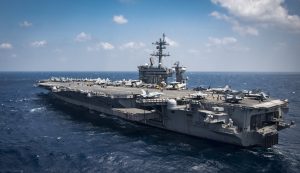It is already an unacceptable reality that China and the United States have taken each other as their largest maritime rivals. China believes the U.S. is intensifying its containment of China at sea: intervening on Taiwan, in the South China Sea, and elsewhere on China’s maritime periphery. Meanwhile, the United States deems that China is trying to dominate the western Pacific and intends to change the maritime order of the entire world.
Undoubtedly, both sides have exaggerated the capabilities and intentions of the other. However, such exaggerations and misunderstandings can hardly be genuinely alleviated in the context of the Sino-U.S. competition. Fortunately, both sides have clearly emphasized the need to avoid war. Strategically, the intentions of both sides are clear: competition but not war.
Nevertheless, wars and conflicts often happen unexpectedly, and the possibility of an accidental escalation of conflict between China and the U.S. is real.
In China’s surrounding waters, including the South and East China Seas, the two militaries have air and sea encounters more than ten times per day and thousands of times every year. There is no denying that the stakes are rising sharply as the number of encounters and their intensity increase.
Additionally, the latest innovations, such as cyberweapons, anti-satellite weapons, hypersonic missiles, long-range anti-ship missiles, quantum computing, and artificial intelligence, have greatly compounded uncertainty. Maritime military systems have become so complex that the boundaries between land, sea, air, space, and cyberspace are blurred. The application of unmanned systems and autonomous weapons also impairs political and moral restrictions on the use of military force, which may lower the threshold for military conflict.
The management of China-U.S. military competition encompasses both strategic and operational issues and therefore must be coordinated. The essential questions in terms of strategy are the extent to which China and the United States can accept each other’s powerful presence and whether both countries can coexist peacefully. The main issue at the operational level is whether the two countries can explore establishing a series of effective maritime and air rules of conduct under different geographical environments, strategic cultures, and decision models.
Considering that most air and sea encounters occur in the waters proximate to China, not the U.S., Washington needs to properly accommodate Beijing’s concerns about sovereignty and national security rather than blaming China for not embracing crisis management mechanisms. From the perspective of Beijing, developing a China-U.S. code of conduct for military encounters would be like giving seat belts to speeders, effectively allowing Washington to manage the risks posed by its military operations in the region surrounding China.
To break the deadlock, building effective crisis management between the two militaries could start with the uncontested high seas in order to minimize the interference from sovereignty and national security issues. This is the conclusion of several China-U.S. expert meetings in recent years.
Existing international law, including the United Nations Convention on the Law of the Sea (UNCLOS), is vague and has few relevant provisions regarding peacetime military operations at sea and in the air. There are already many international rules and bilateral agreements for safeguarding communications between the two militaries. In the case of an unintended incident, it is easy for both parties to conduct emergency communication. There is a hotline between the two presidents and connecting the commanders-in-chief of the respective armed forces.
However, at the mid-levels of command, there are no institutionalized communication channels, for example, between fleets, theater commands, and joint staff departments. In a crisis, commanders at all levels would quickly be involved. Therefore, both parties must establish effective communication mechanisms across various levels of the related headquarters units.
When there is enough practice and trust on the high seas between the Chinese and U.S. militaries, then we can count on them to develop corresponding crisis management mechanisms for the more complex areas of the South China Sea, the East China Sea, and the Taiwan Strait.
In a series of articles, Chinese and American experts intend to make explicit the misperceptions that drive the mistrust in the ever-increasing instability in the bilateral relationship. Find the whole series here.

































